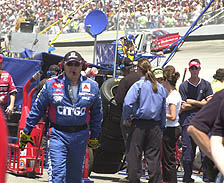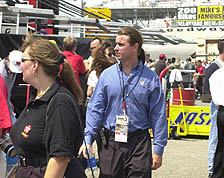|
July 22, 2002
Media spotlight shines on anthropologist's NASCAR
project
By Jennifer McNulty
It's the ultimate in what anthropologists call "participant observer"
research: James Todd was discovered by the media one week after beginning
fieldwork for his doctoral dissertation on "Southern Culture and
Stock Car Racing."
 |
|
Anthropology graduate student James Todd, center, gets a close
look at NASCAR racing.
|
 |
|
Todd's unusual research has been written about in everything
from Sports Illustrated to the Chronicle of Higher Education.
Photos: George Welty
|
Since then, Todd, a Ph.D. candidate in anthropology at UCSC, has been
the subject of articles in Sports Illustrated, the San Jose
Mercury News, the Roanoke Times, the Virginian-Pilot,
the Birmingham News, the Charlotte Observer, and the Greenville
News.
He's even appeared on a classic rock radio station's drive-time morning
show.
"The station was 106.9, "The Fox." It was one of those
funny morning shows," he explained. "It wasn't very scholarly."
At the other end of the spectrum, however, is the Chronicle of Higher
Education, which has also called.
Why all the fuss? Because it's not often that an academic hits the
road in a 15-year-old RV to follow the NASCAR circuit, watching races,
eating barbecue, and exploring the appeal of a sport that's long been
associated with the South.
As NASCAR sheds its southern roots and "goes national," Todd
is traveling along, documenting the transformation of the fastest growing
sport in the country.
"I can't believe someone studying PR is getting so much PR doing
it," said Todd. But Todd is a novelty, and what's novel makes news,
as he has quickly surmised.
"A good chunk of my work is watching the media and the PR people,"
said Todd. "They write the same story every week--who won the race
and what happened. I'm something of a break for them."
So far, the media coverage has been positive, if playful ("Gentleman,
start your thesis" and "[Todd] also spends a lot of time convincing
people that this is serious study and not just a really cool way to
scam a year living a motorhead's dream").
The media results are likely a result of Todd's talent as an interview
subject. A personable and articulate spokesman for his project, Todd
plays along with the jokes while making a convincing case that NASCAR
is ripe for in-depth study.
"I could easily do a very superficial and critical study of masculinity
and race, but there's a much more complex landscape out there,"
he said. "When I start talking about NASCAR and capitalism, regionality,
flows of culture, race and class in the U.S., people start to get the
idea that I'm taking it very seriously."
Todd's two advisers at UCSC are highly supportive of the project. Anthropology
professor Donald Brenneis accompanied Todd to a recent race in California
("He loved it," swears Todd), and Hugh Raffles, associate
professor of anthropology, gave the project his full endorsement from
the beginning, despite his profession's bias against studies within
the United States.
"There's a lot of interest in this as a phenomenon of contemporary
capitalism," said Raffles. "This is a highly commoditized,
spectacular sport. James is very interested in the marketing of NASCAR
and its movement onto a national stage."
Further endorsement came in the form of a $20,000 grant from the Wenner-Gren
Foundation, the top anthropology granting body in the country, and $10,000
from the Krach Family Foundation in Los Gatos. Todd used the money to
buy a motor home to follow the race circuit. With the RV going through
gas at the rate of five miles to the gallon, Todd anticipates taking
out student loans to complete his field research.
There's plenty of material to work with, both inside the track and
around it. Each of NASCAR's 43 licensed drivers supports a team of 50
to 150 people. But Todd isn't focusing on the drivers or the cars. He's
interested in NASCAR as a phenomenon: the fans, the consumerism, the
marketing, and the morphing of a sport steeped in the lore of moonshine
and rednecks.
Despite the lingering impression that NASCAR is a small, backwoods
thing, stock-car racing today claims a fan base of 75 million--up 12
million from last year--or 1 in 4 Americans. It's right behind the NFL
in the number of fans in the critical demographic group of men aged
18 to 34. And NASCAR fans do buy: A mile-long convoy of 18-wheelers
hauls NASCAR merchandise from race to race, filled with everything from
T-shirts and baseball caps to $500 leather jackets. The speedway environment
is, as one writer put it, "vibrant with commerce."
Some fans have dedicated entire rooms of their homes--"shrines"--to
NASCAR memorabilia.
During the past 15 years, NASCAR's efforts to "go national"
have succeeded beyond anyone's wildest dreams. Todd wants to understand
how that's happened.
"I hear rumors of people saying 'Why would he want to do that?
Why would he want to hang out with rednecks?' But I don't think that's
about people not taking me seriously," said Todd. "They're
really not taking NASCAR seriously. This is a lot bigger than the Sunday
football game."
For the next 20 weeks or so, Todd will be attending NASCAR races every
weekend. At the end of the Winston Cup series, he'll begin analyzing
his data and hopes to finish his dissertation by May 2004.
The biggest problem Todd has with reporters is that they all want to
know the same thing: what he's learned. And the answer is simple. "I
don't know yet," he said. "I'm just getting started."
Return to Front Page
|